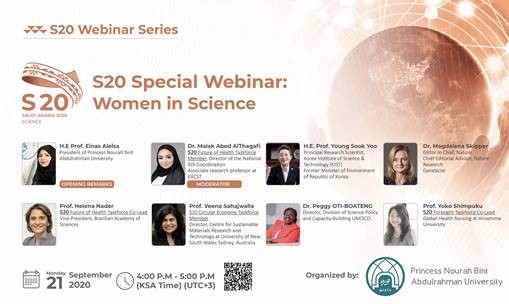In September, the S20 (an engagement group of the G20 established in 2017) was hosted by Saudi Arabia, King Abdullah University of Science and Technology (KAUST) under the chairmanship of Anas Alfaris. The theme for S20 in 2020 is “Foresight: Science for Navigating Critical Transitions,” the intent of which is to underline how science can be used as a tool to guide humanity through critical global transitions. During the S20 cycle, each task force will tackle one of four subtopics: Future of Health, Circular Economy, Digital Revolution and Connecting the Dots.
Yoko Shimpuku (Hiroshima University, Japan), the Executive Committee (EC) portfolio responsible for G7/G20 relations, was appointed as the Co-lead of the S20 Taskforce 4, “Connecting the Dots”. Yoko’s role involved collecting information for the survey on the theme, summarizing the survey data, contributing to the policy paper and the communique, and presenting output at S20 online webinars.
During the information collection phase of the survey, Yoko asked the GYA Science Advice WG for contributions. Subsequently, GYA EC members Nova Ahmed (North South University, Bangladesh), Shalini Arya (Institute of Chemical Technology, India), Robert Lepenies (Helmholtz Centre for Environmental Research, Germany), Sandra Lopez (Gorgas Memorial Institute for Health Studies, Panama), Clarissa Rios (University of Cambridge, United Kingdom), Pradeep Kumar (Wits University, South Africa), Karen Jacqueline Cloete (University of the Western Cape, South Africa), Velia Siciliano (Istituto Italiano di Tecnologia, Italy), and Hong Ching (Universiti Malaya, Malaysia) participated in the discussion. Through this process, Clarissa Rios also got interested in the S20 theme and joined the Taskforce through her university.
As the Co-lead of the Taskforce 4, Yoko presented the recommendations of the Taskforce 4 at the webinar, “Foresight: Science for Navigating Critical Transitions,” on Sep 14th. She was also a panelist of S20 Special Webinar, “Women in Science,” on Sep 21st, and talked about the activities of the GYA Women in Science WG. She presented the activities of the GYA among the panelists composed of the following famous female scientists/leaders: Young Sook Yoo, Principal Research Scientist, Korea Institute of Science & Technology (KIST), Chairperson of the Board, Climate Change Center, Former Minister of Environment of Republic of Korea; Magdalena Skipper, Editor-in-Chief of Nature; Peggy Oti-Boateng, Director, Division of Science Policy and Capacity-Building UNESCO; Veena Sahajwalla, S20 Circular Economy Taskforce Member, Director, Centre for Sustainable Materials Research and Technology at University of New South Wales Sydney, Australia; and Helena Nader, S20 Foresight Taskforce Co-Lead, Vice-President Brazilian Academy of Sciences
At the final S20 Summit, the action plans based on the communique were presented by the representatives of each G20 Science Academy. Because of Yoko’s inputs, the Science Council of Japan mentioned the successful experience of the Young Academy Japan/GYA/INGSA Capacity Building on Science Advice and Science Leadership in 2018 (see news item here: https://globalyoungacademy.net/members-report-international-network-for-government-science-advice-conference-in-tokyo/). Further, the Science Council of Japan signaled their intention for further support for capacity building on Foresight Research especially among young scientists.
The communique and the action plan will be handed to decision-makers (i.e., the President, the Prime Minister, the Minister of Science, etc.) in each G20 country.
The S20 supports the G20 by fostering an official dialogue with the scientific community and is normally led by the national science academy of the host country. The core purpose of the S20 Engagement Group is to present policymakers with consensus-based recommendations for the chosen topics of interest.
The documents of the signed communique should be available online soon. This year’s S20 message was described as “more important than ever” by Nature magazine. Read that article here: https://www.nature.com/articles/d41586-020-02621-w
